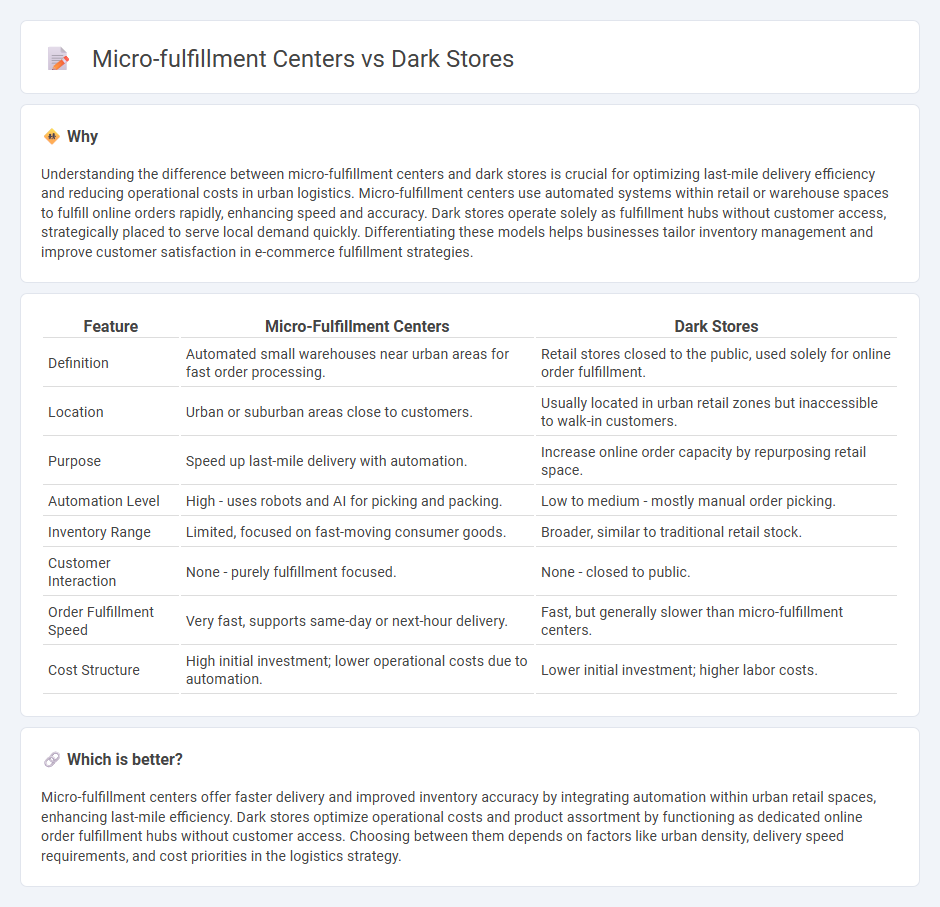
Micro-fulfillment centers optimize last-mile delivery through automated storage and rapid order processing within urban areas, significantly reducing delivery times. Dark stores function as dedicated fulfillment hubs without customer-facing retail space, focusing on efficient inventory management for online orders. Explore the key differences and advantages of each model to enhance your logistics strategy.
Why it is important
Understanding the difference between micro-fulfillment centers and dark stores is crucial for optimizing last-mile delivery efficiency and reducing operational costs in urban logistics. Micro-fulfillment centers use automated systems within retail or warehouse spaces to fulfill online orders rapidly, enhancing speed and accuracy. Dark stores operate solely as fulfillment hubs without customer access, strategically placed to serve local demand quickly. Differentiating these models helps businesses tailor inventory management and improve customer satisfaction in e-commerce fulfillment strategies.
Comparison Table
| Feature | Micro-Fulfillment Centers | Dark Stores |
|---|---|---|
| Definition | Automated small warehouses near urban areas for fast order processing. | Retail stores closed to the public, used solely for online order fulfillment. |
| Location | Urban or suburban areas close to customers. | Usually located in urban retail zones but inaccessible to walk-in customers. |
| Purpose | Speed up last-mile delivery with automation. | Increase online order capacity by repurposing retail space. |
| Automation Level | High - uses robots and AI for picking and packing. | Low to medium - mostly manual order picking. |
| Inventory Range | Limited, focused on fast-moving consumer goods. | Broader, similar to traditional retail stock. |
| Customer Interaction | None - purely fulfillment focused. | None - closed to public. |
| Order Fulfillment Speed | Very fast, supports same-day or next-hour delivery. | Fast, but generally slower than micro-fulfillment centers. |
| Cost Structure | High initial investment; lower operational costs due to automation. | Lower initial investment; higher labor costs. |
Which is better?
Micro-fulfillment centers offer faster delivery and improved inventory accuracy by integrating automation within urban retail spaces, enhancing last-mile efficiency. Dark stores optimize operational costs and product assortment by functioning as dedicated online order fulfillment hubs without customer access. Choosing between them depends on factors like urban density, delivery speed requirements, and cost priorities in the logistics strategy.
Connection
Micro-fulfillment centers and dark stores are interconnected through their shared focus on enhancing last-mile delivery efficiency and order fulfillment speed in the logistics sector. Micro-fulfillment centers are small-scale warehouses located near urban areas designed to facilitate rapid delivery, while dark stores operate as local fulfillment hubs without customer-facing retail functions, optimizing inventory management and reducing delivery times. Their combined use supports omnichannel retail strategies by enabling faster response to consumer demand and minimizing logistics costs.
Key Terms
Inventory Management
Dark stores prioritize local inventory allocation to fulfill online orders quickly, often operating as mini-warehouses within urban areas to reduce delivery times. Micro-fulfillment centers integrate automated systems and robotics to optimize stock levels and streamline picking processes, enhancing accuracy and efficiency. Discover deeper insights into inventory management strategies by exploring the operational contrasts between dark stores and micro-fulfillment centers.
Order Fulfillment Speed
Dark stores operate as local fulfillment hubs designed solely for online order processing, significantly reducing delivery times by proximity to customers. Micro-fulfillment centers integrate advanced automation within or near existing retail spaces to expedite inventory handling, enabling rapid picking and packing of orders. Explore how these innovative models transform order fulfillment speed in modern supply chains.
Last-Mile Delivery
Dark stores serve as local fulfillment hubs designed exclusively for online order processing, optimizing inventory management to expedite last-mile delivery within urban areas. Micro-fulfillment centers integrate automated technologies within existing retail spaces or small warehouses, significantly reducing delivery times by bringing inventory closer to the customer. Explore the advantages and operational efficiencies of both models to enhance your last-mile delivery strategy.
Source and External Links
What Is a Dark Store? - NetSuite - A dark store is a brick-and-mortar location repurposed for fulfilling online orders, often located in cost-effective areas with operations similar to a warehouse.
Dark stores in retail: Concept, benefits, challenges, strategies - Dark stores are retail outlets designed for online order fulfillment, featuring efficient layouts for picking, packing, and delivery.
The Dark Store Model: Advantages, Challenges, and What's Next - Dark stores are fulfillment centers for online orders, closed to walk-in customers, offering faster delivery and lower operational costs through optimized logistics.
 dowidth.com
dowidth.com